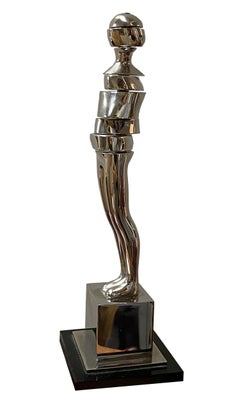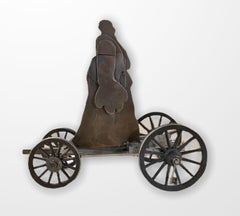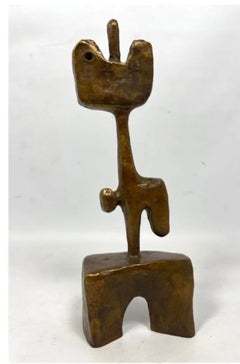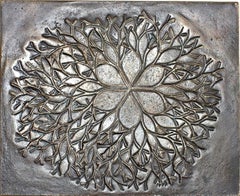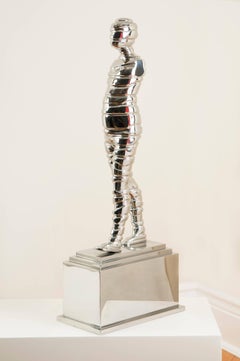Ernest Tino Trova Sculptures
American
Known for his Falling Man series in abstract figural sculpture, he created hard-edge images that brought him widespread attention because they seem to strike a chord of empathy with viewers who recognized themselves as human beings challenged by a technological society. Also, they are the only creatures aware of their mortality. He is considered highly innovative because of his successful combining of technological methods to create his art.
Interpretation as to overall meanings vary with some thinking that it refers to the fall of man in the religious sense and others seeing it as a commentary on the tragic mechanization of society that reduces human beings. Trova has said that "falling" refers to the fact that man moves from one position to the next in an eventual fall to inevitable oblivion" (Kultermann 11).
He has lived his entire life in St. Louis, Missouri although his reputation is nationwide. He did not think it necessary to study art because he believed in his own instincts, although he drew from a variety of sources including figurative painters such as Francis Bacon, Jean Dubuffet, and Willem DeKooning.
The Falling Man series resulted from a unique offer from the Famous-Barr Department Store in St. Louis, where he had worked as a window decorator in his twenties. Store personnel told him that in exchange for creating a series of works to exhibit at the city's 1964 bicentennial celebration, he could have unlimited access to the store's materials and workers. The store's display department was a great setting for him to be creative with his interest in Pop Art, and this project gave him assembly-line assistance of carpenters, electricians, and painters.
The result was that all images had Falling Man figures, and this included paintings, assemblages, collages, and movable sculpture, both electronic and hand driven. After the Bi-centennial, many of the pieces were then shipped to the Pace Gallery in New York City and received critical acclaim.
Of his technique, he has explained that he first creates a cardboard model and then works from there, often making it life size. He is much more interested in variations of shape and form rather than color.
Ernest Tino Trova died at his home in Richmond Heights, near St. Louis, Missouri on March 8, 2009 at the age of 82. (Obituary.New York Times March 13, 2009.)(Biography provided by Gallery of the Masters)
4
4
Overall Height
to
Overall Width
to
3
1
2
1
1
1
1
1
1
1
4
2
33
408
242
230
121
4
3
1
1
Artist: Ernest Tino Trova
Falling Man, 1990
By Ernest Tino Trova
Located in Missouri, MO
Falling Man, 1990 By. Ernest Trova (1927-2009)
6.5" x 2" x 2"
Ed. 50/99
Numbered/Dated on Bottom
*This figure has multiple moving sections
Known for his...
Category
20th Century Abstract Ernest Tino Trova Sculptures
Materials
Stainless Steel
Black Falling Man with Form
By Ernest Tino Trova
Located in Missouri, MO
Ernest Tino Trova
"Black Falling Man with Form" 1996
Bronze
Ed. 1/3
Signed, Dated and Numbered Verso
approx. 16 x 8.5 x 16 inches
Known for his Falling Man series in abstract figura...
Category
1990s American Modern Ernest Tino Trova Sculptures
Materials
Bronze
Car Man, Four Wheels
By Ernest Tino Trova
Located in Missouri, MO
Ernest Tino Trova
"Car Man, Four Wheels"
17 x 8 x 14.5 inches
Inscribed T-06 Bottom
Known for his Falling Man series in abstract figural sculpture, he created hard-edge images that ...
Category
Late 20th Century American Modern Ernest Tino Trova Sculptures
Materials
Bronze
Falling Man and Form
By Ernest Tino Trova
Located in Missouri, MO
Ernest Tino Trova
"Falling Man and Form" 1996
Brass and Bronze
14 x 4.5 x 4.5 inches
Signed and Numbered 1/1 (Unique)
Known for his Falling Man series in...
Category
1990s American Modern Ernest Tino Trova Sculptures
Materials
Bronze, Brass
Related Items
Mexican Art Abstract Brutalist Biomorphic Bronze Sculpture Mathias Goeritz
By Mathias Goeritz
Located in Surfside, FL
Mathias Goeritz (German Mexican, 1915-1990)
Bronze sculpture
Signed and numbered
Dimensions: (approximate) Height: 10 inches, Width: 4 inches, Depth: 2 inches.
This is a cast bronze sculpture in an amorphous figure shape, quite heavy. Reminiscent of the biomorphic sculpture of Hans Jean Arp. This came from an estate and bears his signature It is not dated. there is no accompanying documentation. it is priced accordingly.
Werner Mathias Goeritz Brunner (Danzig, Germany, April 4th, 1915/ now Gdansk, Poland – Mexico City, Mexico; August 4th, 1990).
Mathias Goeritz has had several gallery and museum exhibitions, including at the Museo Nacional Centro de Arte Reina Sofía and at the Museo Experimental El Eco. Numerous works by the artist have been sold at auction, including 'MENSAJE' sold at Sotheby's New York 'Latin American Modern Art' in 2015 for $466,000. There have been Several articles about Mathias Goeritz, including 'LACMA remaps Latin America' written by Suzanne Muchnic for the Los Angeles Times.
Painter, sculptor and Mexican architect associated with the trend of constructive abstraction. He studied medicine at the University of Berlin, but this only lasted a year. The concerns of the young student were aesthetic in nature so he he studied figurative drawing at the Berlin Charlottenburg School of Art. Some of his friends and colleagues were the sculptor Ernst Barlach, painter George Grosz and draughtsman Kaethe Kollwitz. Goeritz studied philosophy and history of art, discipline in which earned a doctorate. He travelled in France, Switzerland, Czechoslovakia, Poland, Austria and Italy, among other countries.
It is known that he left Germany to live in Tetuan, Morocco in 1941 and then Granada, Spain in 1945. In 1946 he had a large exhibition in the Sala Clan in Madrid under the pseudonym "Mago". Two years later, living in Santilla del Mar, Spain he was a founder of the Escuela de Altamira. The following year he married Marianne Gast, writer and his companion for more than fifteen years. In Spain followed his artistic work by important artists of the avant-garde.
Of Jewish descent, he found refuge from the Second World War in Mexico where in 1949 he was invited by Ignacio Diaz Morales to be a part of the faculty of the School of Architecture at the Universidad de Jalisco. In 1953 he wrote the "Manifiesto de la Arquitectura Emocional" (The Emotional Architecture Manifesto), where he points out that only achieving true emotions from architecture can it then be considered an art form. In Mexico he entered controversy with the artistic stablishment of that country; in an open letter, Diego Rivera and David Alfaro Siqueiros described him as "an impostor without the most insignificant talent and preparation" to be an artist. Despite this, in 1957 he was elected director of visual design of the National School of architecture This same year he founded the Museo del Eco in Mexico City. In 1961 Goeritz participated at the Galería Antonio Souza in a group exhibition, Los hartos, for which he published another manifesto. Other participants included Jose Luis Cuevas and Pedro Friedeberg, with whom he was instrumental in establishing abstraction and other modern trends in Mexico.His work is included in the Gelman Collection of modern and contemporary Mexican art based in Cuernavaca, Mexico. Established by Jacques and Natasha Gelman in 1943 as a private collection. it includes many iconic works by major Mexican Modernists including Frida Kahlo, Diego Rivera, David Alfaro Siqueiros, Leonora Carrington, Rufino Tamayo and Francisco Toledo, Lola Alvarez...
Category
20th Century Modern Ernest Tino Trova Sculptures
Materials
Bronze
Bronze Flower Sculpture Plaque
By Ruth Asawa
Located in New York, NY
Ruth Asawa
Bronze Flower, 1979
Cast Bronze relief plaque with original presentation box
5 1/4 × 6 1/4 × 1/4 inches
Numbered from the Edition of 2500
Signed and dated 'Asawa 1979' (lower edge) incised in the bronze; numbered; stamped "Designed Exclusively for Crown Zellerbach Corporation"; foundry copyright
Cast at the Berkley Arts Foundry for Crown Zellerbach
Ruth Asawa's estate is represented by David Zwirner.
Unframed
This beautiful, limited edition signed cast bronze flower plaque makes a distinctive and original gift! It bears the artist's incised signature and is uniquely numbered from the limited edition of 2500. In 1979, the Crown Zellerbach Corporation of San Francisco, which had worked closely with her on neighborhood arts programs, commissioned Asawa to make a series of bronze bas-relief plaques, including this beautiful piece, which were cast by the Berkeley Arts Foundry.
Cast at Berkley Arts Foundry for Crown Zellerbach
Another example of this work was exhibited in the show "On Black Mountain: The Bauhaus Legacy in America", April 5, 2019-April 27, 2019 at the Sager Braudis Gallery in Columbia, Missouri. It is reproduced on page 13 of the exhibition catalogue.
Ruth Asawa Biography
American artist, educator, and arts activist Ruth Asawa (1926-2013) is known for her extensive body of wire sculptures that challenge conventional notions of material and form through their emphasis on lightness and transparency. Born in rural California, Asawa was first exposed to professional artists while her family and other Japanese Americans were detained at Santa Anita, California, in 1942. Following her release from an internment camp in Rohwer, Arkansas, eighteen months later, she enrolled in 1943 in Milwaukee State Teachers College. Unable to receive her degree due to continued hostility against Japanese Americans, Asawa left Milwaukee in 1946 to study at Black Mountain College in North Carolina, then known for its progressive pedagogical methods and avant-garde aesthetic environment. Asawa's time at Black Mountain proved formative in her development as an artist, and she was particularly influenced by her teachers Josef Albers, Buckminster Fuller, and the mathematician Max Dehn. She also met architectural student Albert Lanier, whom she would marry in 1949 and with whom she would raise a large family and build a career in San Francisco. Asawa continued to produce art steadily over the course of more than a half century, creating a cohesive body of sculptures and works on paper that, in their innovative use of material and form, deftly synthesizes a wide range of aesthetic preoccupations at the heart of postwar art in America.
Asawa’s work has been exhibited widely since the early 1950s, including early solo exhibitions at Peridot Gallery, New York in 1954, 1956, and 1958. In 1965, Walter Hopps organized a solo exhibition of the artist’s sculptures and drawings at the Pasadena Art Museum (now Norton Simon Museum) in California, where Asawa completed a residency at the Tamarind Lithography Workshop the same year. Other solo presentations include those held at the San Francisco Museum of Art (1973); Fresno Art Museum, California (2001; traveled to Oakland Museum of California, 2002); de Young Museum, San Francisco (2006); Amon Carter Museum of American Art, Fort Worth, Texas (2012); and Norton Simon Museum of Art, Pasadena, California (2014).
In 2018 to 2019, the Pulitzer Arts Foundation in St. Louis presented Ruth Asawa: Life’s Work, the first major museum exhibition of the artist’s work in more than a decade. An accompanying catalogue published by Pulitzer Arts Foundation and Yale University Press includes essays by Aruna D’Souza, Helen Molesworth, and Tamara H. Schenkenberg. The two-person exhibition, Lineage: Paul Klee and Ruth Asawa was on view at the San Francisco Museum of Modern Art in 2021. In 2022, Ruth Asawa: Citizen of the Universe was on view at Modern Art Oxford, England, and later traveled to the Stavanger Kunstmuseum, Norway. Opening September 16, 2023 at the Whitney Museum of American Art, New York is Ruth Asawa: Through Line, a solo presentation which will later travel to the Menil Drawing Institute in Houston.
The artist’s works have also been included in significant group exhibitions, including Leap Before You Look: Black Mountain College 1933–1957, Institute of Contemporary Art, Boston (2015; traveled to Hammer Museum, Los Angeles, and Wexner Center for the Arts, Columbus, Ohio, 2016-2017); America Is Hard to See, Whitney Museum of American Art, New York (2015); Revolution in the Making: Abstract Sculpture by Women, 1947–2016, Hauser & Wirth, Los Angeles (2017); Making Space: Women Artists and Postwar Abstraction, The Museum of Modern Art, New York (2017); The Pencil Is a Key: Drawings by Incarcerated Artists, The Drawing Center, New York (2019); and In a Cloud, in a Wall, in a Chair: Six Modernists in Mexico at Midcentury, Art Institute of Chicago (2019). A selection of the artist's work was presented at the 59th Venice Biennale, The Milk of Dreams (2022).
In addition to her wire sculptures, Asawa is well known for her public commissions, particularly in San Francisco and the wider Bay Area. These include the much beloved Andrea fountain in Ghirardelli Square (1966-1968) and the San Francisco Fountain outside the Grand Hyatt Union Square (1970-1973), the latter of which includes hundreds of baker’s clay images molded by local schoolchildren, friends, and other artists cast...
Category
Mid-20th Century Modern Ernest Tino Trova Sculptures
Materials
Bronze
Elsie (7/25) - One-of-a-kind Bronze Sculpture
By Nando Kallweit
Located in Los Angeles, CA
German sculptor Nando Kallweit produces figurative bronze sculptures and reliefs with aquiline and a graceful modern appeal. Kallweit is inspired by seemingly disparate cultures; the...
Category
21st Century and Contemporary Abstract Ernest Tino Trova Sculptures
Materials
Metal, Bronze
Aurelia - One-of-a-kind Bronze Sculpture
By Nando Kallweit
Located in Los Angeles, CA
German sculptor Nando Kallweit produces figurative bronze sculptures and reliefs with aquiline and a graceful modern appeal. Kallweit is inspired by seemingly disparate cultures; the...
Category
21st Century and Contemporary Abstract Ernest Tino Trova Sculptures
Materials
Metal, Bronze
Morris Brose "Bronze Bull" Figurative Sculptural Abstract
Located in Detroit, MI
SALE ONE WEEK ONLY
"Bronze Bull" is an exquisite example of Morris Brose's abstract/figurative sculpture. No soft edges on this piece and no invitation to caress, the power, strength and beauty of the bronze are front and center and create awe. "Bronze Bull" is a free-standing piece signed on the base.
Morris Brose, Polish/American was born in Wyszkow, Poland. He became a sculptor and instructor of sculpture at the Detroit Institute of Arts, Wayne State University and Cranbrook Academy of Art, Bloomfield Hills, Michigan. Cranbrook was designed by architect and faculty member, Eliel Saarinen who collaborated with Charles and Ray Eames on chair and furniture design. Numerous creative artists who are alumni of Cranbrook include: Harry Bertoia, Florence Knoll, Jack Lenor Larsen, Donald Lipski...
Category
Late 20th Century Modern Ernest Tino Trova Sculptures
Materials
Bronze
Josie - Elegant Original Figurative Bronze Sculpture
By Nando Kallweit
Located in Los Angeles, CA
German sculptor Nando Kallweit produces figurative bronze sculptures and reliefs with aquiline and a graceful modern appeal. Kallweit is inspired by seemingly disparate cultures; the...
Category
21st Century and Contemporary Abstract Ernest Tino Trova Sculptures
Materials
Metal, Bronze
Hera - Graceful Modern Figurative Bronze Sculpture - Original Art and Design
By Nando Kallweit
Located in Los Angeles, CA
German sculptor Nando Kallweit produces figurative bronze sculptures and reliefs with aquiline and a graceful modern appeal. Kallweit is inspired by seemingly disparate cultures; the...
Category
21st Century and Contemporary Abstract Ernest Tino Trova Sculptures
Materials
Bronze, Metal
José - One-of-a-kind Male Cubist Sitting Figure Original Bronze Sculpture
By Nando Kallweit
Located in Los Angeles, CA
German sculptor Nando Kallweit produces figurative bronze sculptures and reliefs with aquiline and a graceful modern appeal. Kallweit is inspired by seemingly disparate cultures; the...
Category
21st Century and Contemporary Abstract Ernest Tino Trova Sculptures
Materials
Bronze, Metal
Mid Century Bronze Sculpture -- Poseidon's Fury
By Daniel Albert Harris
Located in Soquel, CA
A rare sculpture by Daniel Albert Harris (aka: Zev- the Wolf) (1914-1986) c. 1968 A substantial and stunning bronze sculpture of Poseidon (or Neptune) riding on a shell driven by hor...
Category
1960s American Modern Ernest Tino Trova Sculptures
Materials
Bronze
Eleonora - One-of-a-kind Bronze Sculpture
By Nando Kallweit
Located in Los Angeles, CA
German sculptor Nando Kallweit produces figurative bronze sculptures and reliefs with aquiline and a graceful modern appeal. Kallweit is inspired by seemingly disparate cultures; the...
Category
21st Century and Contemporary Abstract Ernest Tino Trova Sculptures
Materials
Metal, Bronze
Couple
By Agustín Cárdenas
Located in New Orleans, LA
Infused with a crisp modernity and subtle sensuality, this bronze sculpture by Cuban-born artist Agustin Cárdenas is an exceptional example of late-2...
Category
20th Century Modern Ernest Tino Trova Sculptures
Materials
Marble, Bronze
Harmony, 20th century bronze & green marble base, nude man and woman with lyre
By Max Kalish
Located in Beachwood, OH
Max Kalish (American, 1891-1945)
Harmony, c. 1930
Bronze with green marble base
Incised signature on right upper side of base
14 x 9 x 5 inches, excluding base
17 x 10 x 8 inches, including base
Born in Poland March 1, 1891, figurative sculptor Max Kalish came to the United States in 1894, his family settling in Ohio. A talented youth, Kalish enrolled at the Cleveland Institute of Art as a fifteen-year-old, receiving a first-place award for modeling the figure during studies with Herman Matzen. Kalish went to New York City following graduation, studying with Isidore Konti...
Category
1930s American Modern Ernest Tino Trova Sculptures
Materials
Marble, Bronze
Previously Available Items
Wrapped Steel Man
By Ernest Tino Trova
Located in Miami, FL
This high polished stainless steel man is one of the works Trova is most famous for. His walking men are in many museum and private collections. This work i...
Category
1970s Post-Modern Ernest Tino Trova Sculptures
Materials
Stainless Steel
Ernest Tino Trova "Untitled" Sculpture Study of the Fallen Man, American
By Ernest Tino Trova
Located in New York, NY
This compelling sculpture, executed in brass circa 1960, represents a study for Ernest Tino Trova's most iconic body of work, "The Falling Man". Trova is a celebrated American surrea...
Category
1960s Surrealist Ernest Tino Trova Sculptures
Materials
Brass
Ernest Tino Trova sculptures for sale on 1stDibs.
Find a wide variety of authentic Ernest Tino Trova sculptures available for sale on 1stDibs. You can also browse by medium to find art by Ernest Tino Trova in metal, bronze, brass and more. Much of the original work by this artist or collective was created during the 20th century and is mostly associated with the modern style. Not every interior allows for large Ernest Tino Trova sculptures, so small editions measuring 2 inches across are available. Customers who are interested in this artist might also find the work of Stanley Bleifeld, Dudley Vaill Talcott, and Suzan Etkin.
